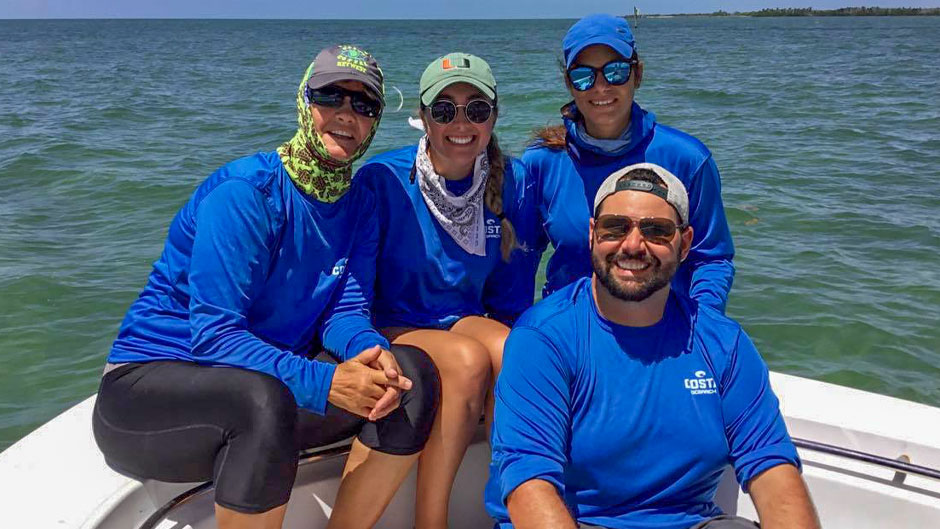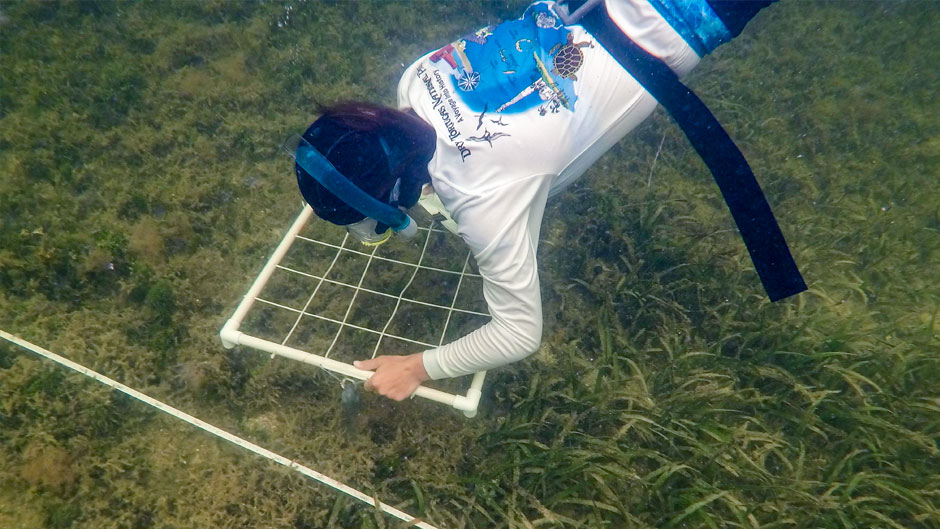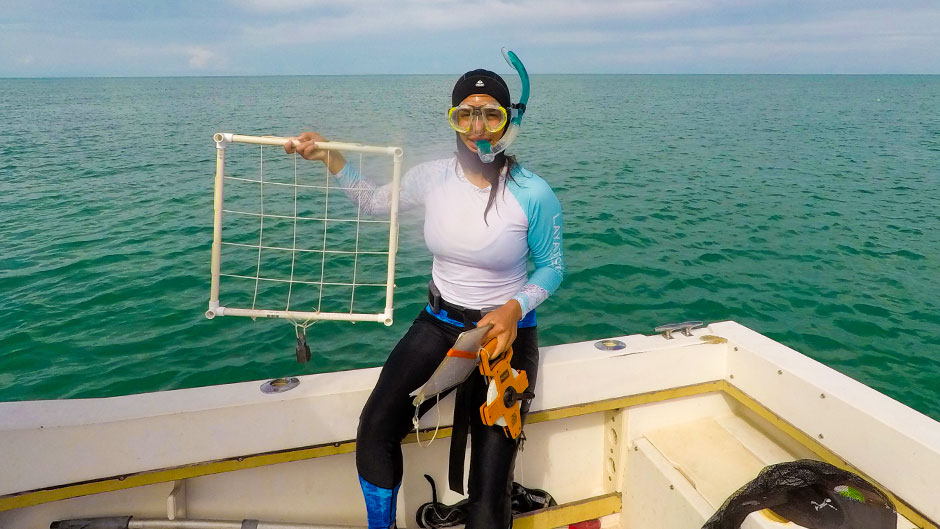The presence and diversity of nearshore corals in the Florida Keys has decreased dramatically throughout the past 30 years, and the colorful fans and sponges that used to inhabit these shallow waters are likely disappearing because of the deteriorating water quality around the islands, new research from the University of Miami indicates.
“The coral assemblages in the nearshore Florida Keys today present an unprecedented loss of species diversity,” wrote biology doctoral graduate Zoi Thanopoulou, biology professor Kathleen Sullivan Sealey, and doctoral graduate Jacob Patus, in a study published recently in the journal, Frontiers in Marine Science.
The three spearheaded a two-year study where they surveyed 13 sites along the island chain, collecting water samples from the shoreline to 500 meters offshore, and snorkeling to identify seagrass and stony corals on a quarterly basis. Using a randomized block system to pinpoint new locations in the same area at the study sites, the team collected water samples and took photos of coral in the Lower, Middle, and Upper Keys. After each trip, water quality results were submitted to the Florida Department of Environmental Protection as part of a state watershed information network (WIN), but the water quality data also helped the researchers explain the degradation of nearshore coral communities.
Of the 13 different study sites, the team found two with no nearshore coral at all, whereas two sites in the Lower Keys had up to eight varieties of nearshore coral.
“The significant differences observed between coral absent and coral present sites . . . support the idea that water quality plays an important role in corals’ occurrence,” the study indicated.

The findings come amid a decline in coral reefs worldwide because of bleaching and disease that scientists believe are propelled by rising water temperatures and poor water quality. According to the United Nations’ Global Coral Reef Monitoring Network, from 2009 to 2018, there was a 14 percent decrease in the world’s hard coral cover.
Sealey has watched this unfold in South Florida and the Bahamas, where she does most of her research. In 1993, Sealey collected data that found up to 20 different species of stony corals close to shore at one site, yet these new study sites found a maximum of just eight different coral species in the Keys.
“Water influences all the stages of a coral’s life history. If you don’t have good water quality, you’re going to impact the recruitment, growth, and reproduction of corals,” said Sealey, who has studied coastal ecology for three decades.
Since the late 1990s, local officials in the Keys have noticed the worsening water quality just offshore. As the Keys have undergone rapid development, runoff water from the streets—which often contains chemicals from fertilizers and other pollutants—as well as leakage from septic tanks have caused a host of harmful nutrients to seep into the waters surrounding the Keys. Over time, these nutrients have changed the composition of the ocean water, increasing the level of chlorophyll—or algae growing in the water. This process, which scientists call eutrophication, is occurring in coastal communities across the United States.
“We saw higher chlorophyll levels, lower dissolved oxygen, and a more acidic pH level as the elements in the water that were influencing the absence of corals the most,” Thanapoulou said.
These factors are adversely affecting the water quality, as well as the coral and seagrass communities close to shore. And the consequences could connect to deeper-water coral reef communities, where a quarter of the ocean’s marine species thrive. Nearshore coral communities are nurseries for some fish species and lobster that later move on to the larger coral reefs, Thanopoulou added.
“We have legacy nutrients from decades of dumping and unfortunately, now it will likely take decades to move offshore,” Sealey said. “You can think of the ocean in terms of public health. If there’s lead in the water and you drank it, you can’t get rid of all the lead from your body immediately, even if you stop drinking the water.”
The University research team also discovered that there was a noticeable difference in the variety and number of coral species found in the Upper Keys, compared to the Middle and Lower Keys. While the nearshore waters off Key Largo had little to no stony corals, the team found up to eight different species in the Lower Keys. This finding was also supported by water quality data that showed higher chlorophyll levels, and more nutrients—like nitrogen and phosphorous—were present both east and west of the Upper Keys.
Some of the most common corals they found close to shore were starlet corals (classified as Siderastrea radians), thin finger coral (Porites divaricata), and golf ball corals (Favia fragum). However, these were limited to the Lower Keys, the authors reported in their study.
“There are higher environmental pressures acting upon the Upper Keys, whereas in the middle and lower Keys there is less development close by and they are farther away from bodies of water that have higher levels of nutrients,” Thanopoulou said, referring to the fact that polluted water from Miami drifts south to the Keys and nutrient-filled water also flows south from Lake Okeechobee into Florida Bay, west of the Keys.
The team also noted that water quality was worse on the western side of the Keys in Florida Bay.
“Nutrients are retained longer on the bayside versus the oceanside, which makes sense because the bayside is a basin with a set of rocks (i.e., the Keys) blocking water circulation,” Patus said.
As a result of the pollution, Monroe County officials constructed a massive, advanced wastewater treatment network that was largely completed in 2017 to help mitigate further damage to the coastal water and marine ecosystems surrounding the archipelago. They are hoping to implement measures that could further improve the water quality around the canals, which are often the most problematic.
Yet, Sealey said that she now believes the way to truly improve water quality is to think larger. She was part of the movement to create the 3,800 square mile Florida Keys National Marine Sanctuary established in 1990, which protects the Florida Reef Tract from Miami south to the Dry Tortugas. However, it only protects reefs that are well offshore.
“We put a lot of faith into marine protected areas saving marine life, but we are finding out that those areas need to be bigger and to include the shoreline,” she said.
Sealey was contracted by Monroe County to survey the nearshore water quality throughout the Keys from 2018 to 2021. Other publications from Sealey, Patus, and Thanopoulou are still forthcoming and will address the water quality of the canals found throughout the Keys.


